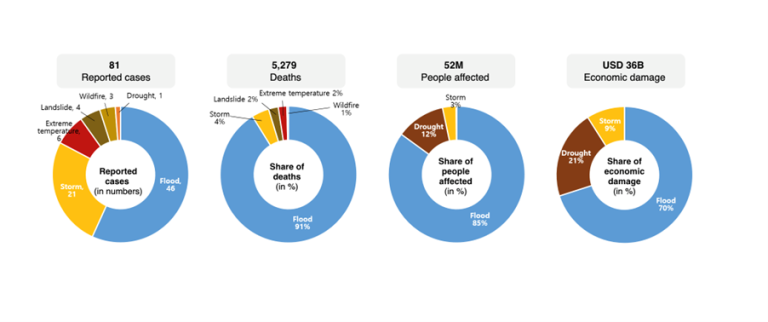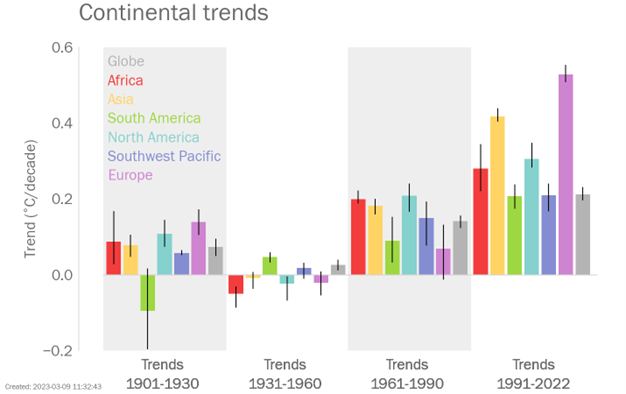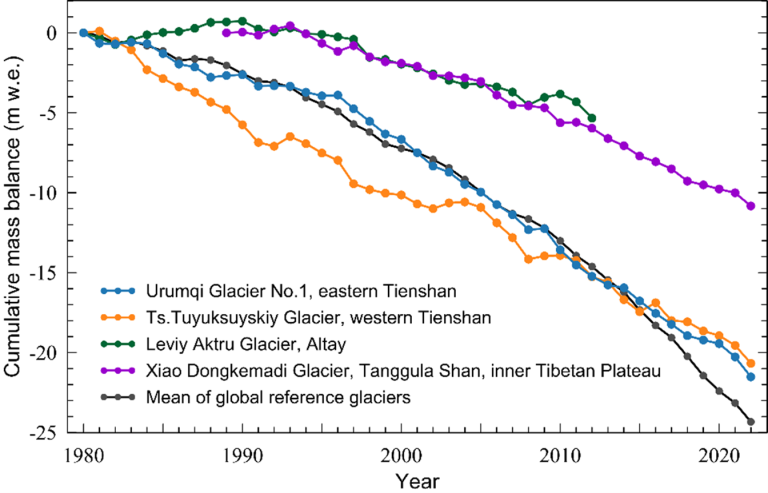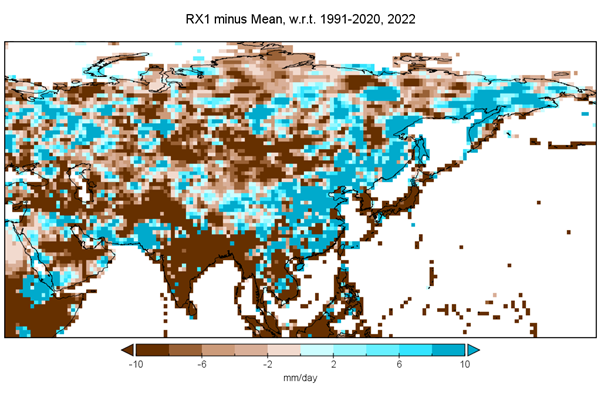Climate change impacts increase in Asia
Bangkok, Thailand - Extreme weather and climate change impacts are increasing in Asia, which ricocheted between droughts and floods in 2022, ruining lives and destroying livelihoods. Melting ice and glaciers and rising sea levels threaten more socio-economic disruption in future, according to a new report from the World Meteorological Organization.
- Long-term warming trend accelerates
- Asia is world’s most disaster-prone region
- More than 80 disasters killed more than 5 000 people and affected 50 million
- Drought and floods most common hazards
- Melting glaciers threaten future food and water security

Asia, the continent with the largest land mass extending to the Arctic, is warming faster than the global average. The warming trend in Asia in 1991–2022 was almost double the warming trend in the 1961–1990 period, according to the WMO State of the Climate in Asia 2022 report.
There were 81 weather, climate and water-related disasters in Asia in 2022, of which over 83% were flood and storm events. More than 5 000 people lost their lives, more than 50 million people were directly affected and there were more than US$ 36 billion in economic damages, according to the report. In addition, a large part of arid Asia experienced severe dust storms. Several severe dust storm events in western Asia affected civil lives in the region.
“This report summarizes the state of the climate and the extreme events and their socioeconomic impacts in Asia in 2022. In 2022, many areas in Asia experienced drier-than-normal conditions and drought. China, in particular, suffered prolonged drought conditions, which affected water availability and the power supply. The estimated economic losses from the drought affecting many regions in China were over US$ 7.6 billion. Pakistan, by contrast suffered disastrous flooding,” said WMO Secretary-General Prof. Petteri Taalas.
“Most glaciers in the High Mountain Asia region suffered from intense mass loss as a result of exceptionally warm and dry conditions in 2022. This will have major implications for future food and water security and ecosystems,” he said.

The report, one of a series of WMO regional State of the Climate reports, was released during a meeting of the UN Economic and Social Commission for Asia and the Pacific’s (ESCAP) Committee on Disaster Risk Reduction.
“The United Nations Secretary-General’s “Executive Action Plan on Early Warnings for All,” co-led in implementation by WMO and the United Nations Office for Disaster Risk Reduction (UNDRR), is more critical in Asia, which is the world’s most disaster-impacted region and where the effects of transboundary climate-related disasters are on the rise,” said Armida Salsiah Alisjahbana Under-Secretary-General of the United Nations and Executive Secretary of ESCAP.
The report is accompanied by an interactive story map, with a special focus on agriculture and food security. The expected increase in the frequency and severity of extreme events over much of Asia will impact agriculture, which is central to all climate adaptation planning.
“Impact-based forecasting, early warnings for all, and their translation into anticipatory action are examples of the transformative adaptation needed to strengthen the resilience of food systems in Asia,” said Ms. Salsiah Alisjahbana

The mean temperature over Asia for 2022 was the second or third warmest on record and was about 0.72 °C above the 1991–2020 average. The 1991–2020 average was itself about 1.68 °C above the WMO 1961–1990 reference period for climate change.
Drought affected many parts of the region, reducing water availability. The economic losses in 2022 as a result of the drought in China, for example, were estimated to exceed US$ 7.6 billion.
Severe flooding hit Pakistan, causing significant loss of life and economic damage. Pakistan received 60% of its normal total monsoon rainfall within just three weeks of the start of the monsoon season in 2022. According to the National Disaster Management Authority (NDMA), more than 33 million people, almost 14% of Pakistan’s 2022 population, were affected.
Glaciers in the High Mountain Asia region have lost significant mass over the past 40 years, and the loss is accelerating. In 2022, exceptionally warm and dry conditions exacerbated the mass loss for most glaciers. Urumqi Glacier No. 1 in the eastern Tien Shan recorded the second highest negative mass balance of -1.25 metre water equivalent since measurements began in 1959.

The ocean. The region shows an overall surface ocean warming trend since the time series began in 1982. In the north-western Arabian Sea, the Philippine Sea and the seas east of Japan, the warming rates exceed 0.5 °C per decade, which is about three times faster than the global average surface ocean warming rate.
Record-breaking winds and heavy rainfall associated with Typhoon Nanmadol were observed in several stations in Japan in September. Nanmadol was associated with five reported deaths, affected over 1 300 people, and caused estimated economic damages in excess of US$ 2 billion.
According to the International Disaster Database (EM-DAT), in 2022, 81 natural hazard events were reported in Asia; of these, over 83% were flood and storm events. These events led to over 5 000 fatalities, 90% of which were associated with flooding. Overall, natural hazard events directly impacted more than 50 million people and resulted in over US$ 36 billion in damages.
Economic losses in 2022 due to disasters relating to floods exceeded the average for the 2002–2021 period. The most significant losses of this type were in Pakistan (over US$ 15 billion), followed by China (over US$ 5 billion), and India (over US$ 4.2 billion). Economic losses in 2022 associated with droughts were the next largest category, causing US$ 7.6 billion in damages (mainly in China); this exceeds 2002–2021 average (US$ 2.6 billion) by nearly 200%.
Enhancing food system resilience is a high priority in Asia, as was emphasized in the Nationally Determined Contributions (NDC) of most of the parties to the Paris Agreement in WMO Members in the Regional Association II. Monitoring the past and current climate and providing forecasts on weather and climate timescales are fundamental tools underpinning effective early warning services for agriculture and food security.

The World Meteorological Organization (WMO) is a specialized agency of the United Nations responsible for promoting international cooperation in atmospheric science and meteorology.
WMO monitors weather, climate, and water resources and provides support to its Members in forecasting and disaster mitigation. The organization is committed to advancing scientific knowledge and improving public safety and well-being through its work.
For further information, please contact:
- Clare Nullis WMO media officer cnullis@wmo.int +41 79 709 13 97
- Region:
- Region II: Asia

